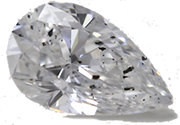Imperfections give
character to diamonds
Diamond Imperfections – More Than One KindImperfections In Diamonds – An introductionThere are very few “perfect” diamonds out there. Those that have absolutely no internal inclusions carry the IF (Internally Flawless) rating for clarity. This represents only one in every 5000 jewelry-worthy diamonds. Almost every diamond has imperfections, but the clarity grading of a stone will reflect how visible these imperfections are. For example, VVS1-VVS2 diamonds (very, very slightly included)contain inclusions that are hard to see with a jeweler’s loupe. A diamond with an I1-I3 clarity grading, on the other hand, will contain inclusions that can be easily noticed with the naked eye. Diamonds with an SI1 rating will usually be eye clean - the imperfections will be difficult to see from the naked eye. It is important to note that there are several types of imperfections, some being less desirable than others. Understanding Imperfections In DiamondsWhen considering a diamond purchase, it may be worth inquiring about the types of inclusions which may be present in diamonds. Some imperfections may bother you more than others. The GIA grading lab uses a diamond plot to indicate the type of blemish in the stone as well as plot it on a map of the diamond to show where it is in the stone. It is important to note that when considering how the diamond will look to the naked eye, the clarity grading, rather than the plot, will indicate this. For example, one diamond can have a VS2 grading while another stone with the exact same plot can have an SI2 grading. Here are some of the most common types of inclusions in diamonds. 
CavityThis is also referred to as a “hole” and is a flaw that usually occurs during the polishing process, often when a crystal inclusion gets displaced from the diamond’s body. The most common reason for not “polishing off” the cavity is due to the weight loss of the diamond that stands to be incurred, rendering it better from an economics perspective not to do. Crystals
These are minerals that find their way into the diamond. They can be white, as well as greenish, reddish or black,
the color depending on the type of mineral in the stone. Colored crystal inclusions are far less popular as they
are more visible to the naked eye. For example, this 2.07 carat princess cut diamond with an F color and I1 clarity
grading has several crystal inclusions. It also contains feathers, clouds, indented naturals and an extra facet.
Here is a plot mapping the type of imperfection and where on the diamond they are located, taken from a GIA
certification.

CloudThis is a mass of small inclusions, such as pinpoints and crystals grouped extremely close together, usually giving it the appearance of being one larger inclusion. Larger clouds will usually result in a “cloudy” appearance in the stone, which is likely to result in the diamond exuding less light. This video shows a 1.56 carat IGL certified marquise diamond with SI2 clarity and an F clarity grading. It contains several small and large scattered imperfections, making it non-eye-clean, both face-up and face-down. FeatherA small fracture or crack inside the stone. While this imperfection will not always be so visible, thereby not acting as a deterring to a customer, there are certain things to look out for. For example, diamonds with feathers nearer the surface of the stone or near the girdle may be less durable. NeedleA needle-shaped imperfection appearing in the diamond, usually transparent or white. A diamond with containing a needle may still be eye clean, but many needles clustered may seriously lower the clarity grading of a diamond. For example, this 1.51 carat cushion fancy intense purple-pink HPHT color treated SI2 clarity graded IGL certified diamond contains two small needle inclusions.  ,SI2) IGL Certified.png) PinpointsSeveral small black or white crystals rooted inside the diamond. Black pinpoints are usually more noticeable with the naked eye than white pinpoints. Twinning WispsThis imperfection forms itself in the formation process of the diamond. While a diamond is being created, it may stop growing due to a change in conditions. Thousands of years later, when the process resumes, the conditions are unlikely to be the same and the diamond is likely to continue to grow in a different manner. This imperfection is likely to be an amalgamation of several other imperfections, such as crystals, feather, pinpoints and clouds. ChipThis is a chip found on the surface of the diamond, usually caused by accidental damage or wear and tear. The chip would most likely be found near where facets meet or by close to the edges of the diamond. Indented Natural FlawAn indented natural flaw tends to be found in the girdle of a diamond. In contrast to a chip, it is a natural imperfection that has not been touched by the cutter during the polishing process. BruiseThis is a chip in the diamond that is often rooted deeper inside the diamond with feathers.NaturalOften found on the girdle, this type of imperfection is the result of parts of the diamond remaining unpolished. Extra FacetSometimes, when there is a specific type of flaw in a rough diamond, the cutter may end up creating an extra facet in the diamond that is not a part of the standard cut of that shape. For example, a round cut diamond that usually has 58 facets (including the culet), may now have 59 facets. Depending on how dramatic the extra facet, this may not always be visible to the naked eye. If you have any questions about diamond imperfections, diamond clarity ratings or any other aspect of diamond jewelry, we can always be contacted on 1-800-557-7095 where one of our expert diamond jewelers will be happy to assist you. Alternatively, you can email us at [email protected] with any questions you may have. |



.jpg)